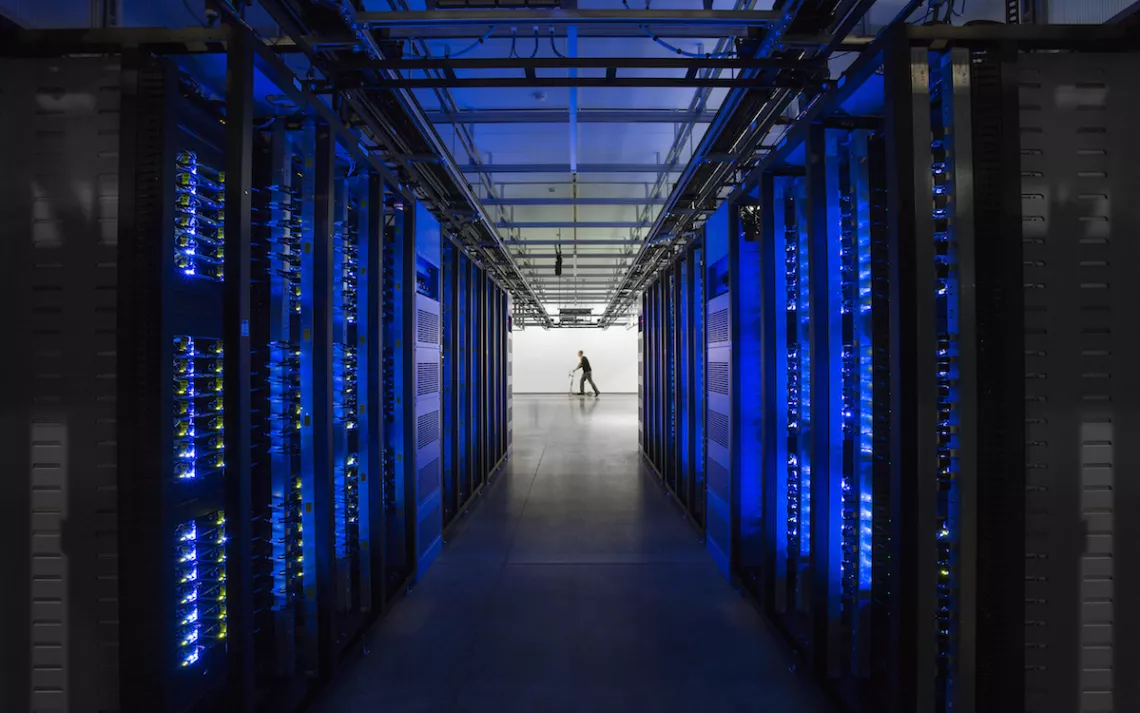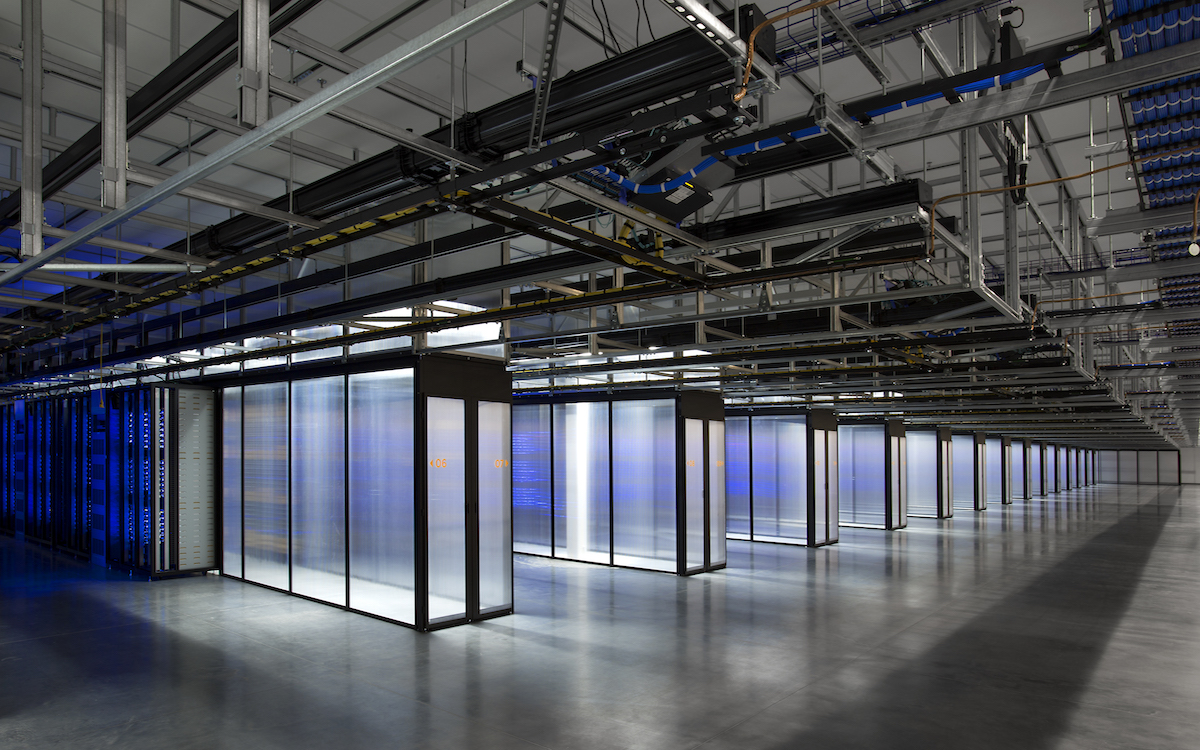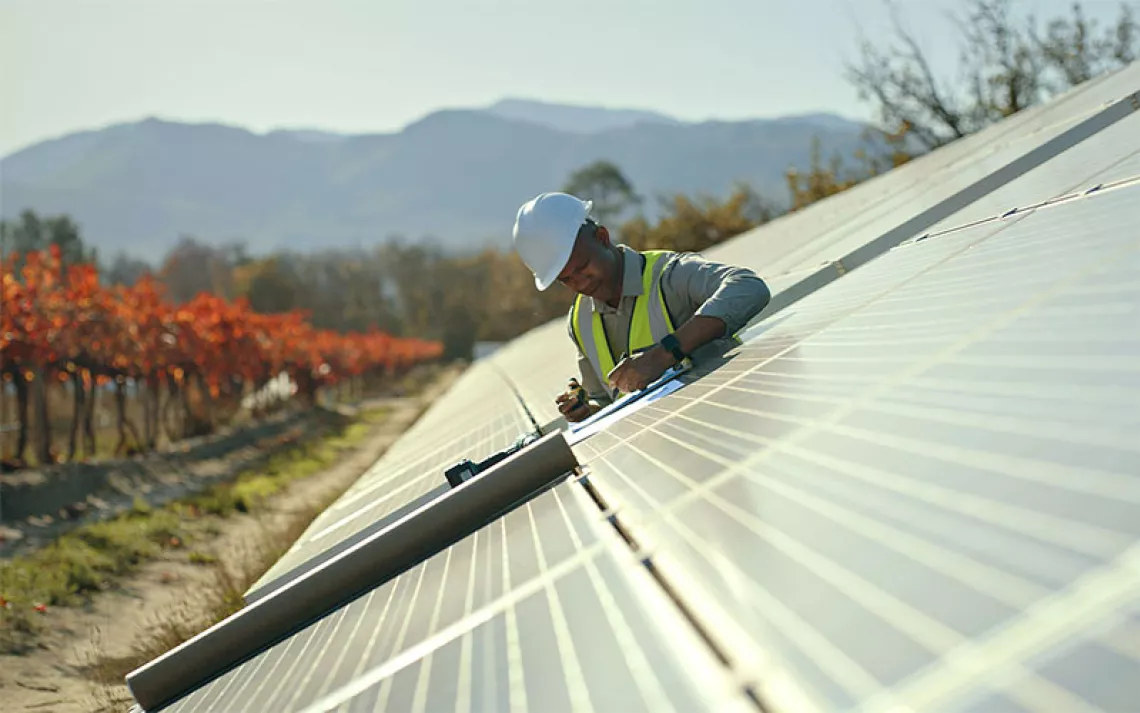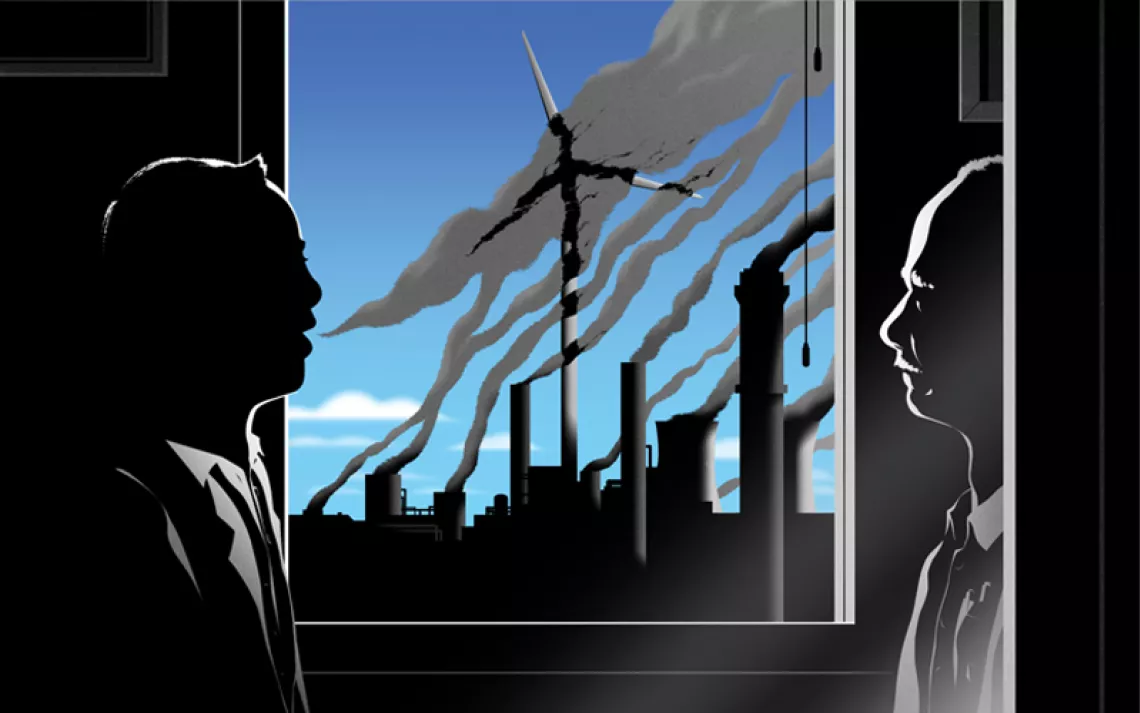Data Centers Work for Sustainability With or Without Federal Leadership
Facebook and other tech giants are committed to 100 percent renewable energy

Photos courtesy of Jacob Sharp for Facebook
Facebook’s data center in Altoona, Iowa, sits adjacent to a Flying J truck stop, across the highway from a Bass Pro Shop and Adventureland, the local amusement park. The gray, nondescript complex easily blends into the landscape of strip malls and fast-food joints. That’s exactly how Facebook wants it to be: an anonymous site securely and quietly housing every user transaction ranging from profile pictures to personal updates to people’s political rants.
Facebook’s data center may be low-profile, but the company’s commitment to sustainability is anything but. The social media giant is at the forefront of corporate energy-efficiency initiatives and renewable-energy adoption as it seeks to slash the electricity and water use of its global operations. The company’s Altoona data center was its first server farm in the United States to use 100 percent renewables. Facebook executives say it won’t be the last.
“Every time we do this we want to make it a little bit easier for us and for others,” says Bill Weihl, Facebook’s sustainability director (and also, full disclosure, a member of the Sierra Club Foundation Board of Directors).
The United States is home to about 3 million data centers, which, together, consume more than 2 percent of the nation’s electricity, according to the U.S. Department of Energy. Even with some of the most efficient data centers on the planet, Facebook is no exception. In 2016, Facebook’s carbon footprint totalled 718,000 metric tons of carbon dioxide equivalent, more than two-thirds of which came from its data centers.
“They [data centers] are not as apparent to everybody as, say, the highway and all the cars that are on it that are giving off greenhouse gas emissions,” says Kelly Gallo, manager of advisory services at Business for Social Responsibility (BSR) and director of the nonprofit’s Future of Internet Power initiative. “People don’t see that, but the companies do.”
While President Donald Trump has announced the United States will pull out of the Paris climate agreement, hundreds of companies have signed public clean-energy commitments or joined collaborations such as the Renewable Energy Buyers Alliance to maintain their emissions reduction goals. Tech companies are leading the way. In part, this is because making data centers more energy efficient is simply smart business. If all U.S. data centers were 20 percent more efficient, according to the Department of Energy, they could collectively save more than 20 billion kilowatt-hours by 2020, which translates to approximately $2 billion in cost savings.
“Operational costs are driven by energy consumption, so good stewardship of energy use is good for business,” Bob Landstrom, Interxion’s director of product management, wrote to Sierra in an email.

Facebook data hot aisle.
Corporate interest in renewable energy has grown tremendously over the past five years, with the scale of purchases from companies growing by a factor of 20 to 30 times, according to Weihl. In 2015, more than half of new wind contracts by volume of megawatts were signed by corporate clients, not utilities.
“That had never happened before,” Weihl says. “[Companies] have become a significant fraction of the market for clean energy in this country.”
Facebook hopes to be 50 percent powered by renewables by 2018; Google says its operations will run on 100 percent clean energy by this year, and Apple says it already does. Amazon says half of the electricity used by its data centers will come from renewable sources by the end of this year.
Facebook currently has nine data centers—six in the U.S. and three in Europe—either operational or under construction, all designed to prioritize energy and water efficiency. The company’s design differs from traditional data centers, Weihl said, by relying on outside air to cool its servers, rather than the traditional method of using insulated cooling systems and water-intensive chillers.
The Altoona facility includes three rectangular data buildings, each occupying at least 450,000 square feet, with a fourth under construction. After passing through the buildings’ outermost layer—which houses a cafeteria, an office space, and Iowa-themed conference rooms like “First to Caucus” and “Children of the Corn”—the site’s highly efficient design becomes apparent, signaled by a change in decibel level and differential pressure.
In what is nicknamed “The Penthouse,” outside air is filtered through a series of compartmented rooms, where it is closely monitored and modulated before ever circulating among the servers. Servers need to be kept within an ideal temperature range of 60 to 85 degrees F, and the facility’s main concern is too much condensation.
On an 80-something degree morning in late June, a day when many nearby homes pump AC through their vents to evade the day’s heat, no water flows through the honeycomb-like fiberglass filtration system. This is the case eight to nine months out of the year, according to site manager Brice Towns.
“Most of the time we get free cooling,” Towns says. “All we need to do is pump it.”
By the time air reaches the central network core, the pulsing puffs reach the happy medium of temperature and humidity. A vast series of server aisles alternate between cold air being filtered in and hot air being captured to be reused. Motion-sensored lights guide the 30 to 40 technicians—aided by mobile workstations and scooters to cover the halls’ significant length—to work around the clock ensuring constant functionality.
“We know our impact; we have to be conscious of every single watt,” Towns says. “Nobody is resting. We are constantly looking to innovate.”
The electricity to power the massive operation originates from a wind farm in Wellsburg, Iowa, 90 miles to the north. Facebook struck a special agreement with the state’s monopoly utility, MidAmerican, to build the 140MW wind farm, which was completed in 2014. Today, more than enough clean energy flows onto the grid to power Facebook’s data center.
While Facebook, along with other tech titans like Google and Apple, have market muscle to build their own data centers, the vast majority of companies do not. Instead, they rely on shared data centers, known as co-locations, and have less control over their energy sources.
“When you’re one of many, and the larger infrastructure, the heating, the cooling is all provided by your landlord, in essence, it makes it harder to distinguish your footprint,” says Gallo, who has worked with BSR member companies to ensure that companies ask the right questions when trying to purchase renewable energy.
Facebook hopes to boost efficiency across the industry by open sourcing its designs. It founded the Open Compute Project in 2011 to share its findings with other companies looking to build data centers. The mutually beneficial collaboration propels the whole industry forward faster, Weihl says.
Beyond sharing designs, companies are collaborating to make renewable energy more readily available in bulk. Facebook, along with about a hundred other companies, has been working with utilities to develop what are called Green Energy Tariffs so that data centers and other large electricity users can choose clean power options. So far, these tariffs exist for 13 utilities and 11 states, including in both New Mexico and Nebraska, the locations of Facebook’s next data centers.
“If you’re a company that has a clean energy goal, when you’re looking to build a new facility, we certainly give very strong preference to places that make it easy to meet those goals,” Weihl says. “I think other companies are taking that same approach.”
 The Magazine of The Sierra Club
The Magazine of The Sierra Club







